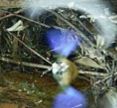“The frequent and consistent rate at which parental Mangrove Pittas (Pitta megarhyncha) were feeding their seemingly seen three life chicks via my field scope, demanded house-cleaning. Their excretions would have to be dealt with and nest kept clean and odour free to detract potential predators to the nesting site.
“The physiological aspect of chicks removing their waste products is through collection of their poo in a white membrane called faecal sac and subsequently evacuated through the anal canal.
“It was observed that when ‘potty’ time was due, a parent after feeding chick did not fly off immediately but stayed, communicated and waited for some sort of an exchange at the entrance of the nest (below left).
“The scene changed when a chick turned around to expose its posterior. The chick was seen expelling the faecal sac. In the process, the midwife parent pecked and fished out the appearing white, pearl looking sac and flew off with the waste (above centre and right).
“How Mother Nature and their feathered parents played out this interesting scenario was worth capturing in movie mode. An unusual observation took place in one of the observations. A chick was seen with faecal sac in its mouth! The chick managed to scramble to the nest’s entrance, to the awaiting parent to have its poo removed my AvianWaste Express Oral – Speciale (left).
“Remnant poo was partially seen in throat of one chick.
“All images of birds taken in this documentation series were taken by digiscopy technique, no less than 20 feet from subject and more than 35 feet from nesting site. Great care was taken to ensure my presence and position did not generate undue stress nor compromise routine feeding of chicks. No attempts were made to investigate or be close to nesting site to eye view eggs or chicks at anytime as descriptions of such are already available in bird field guides and reference books.
“A total of 4+1 selected visits were made to the location to extract sufficient observations in compiling the series. All observations were done via binoculars 8×42 and Fieldscope during a window period of 27 days from 1st sighting of parental Pitta with nesting material to the last day where 3 viable chicks were seen in nest.
“The 5th visit saw a vacated nest within 72 hours of previous sighting.”
AVIAN WRITER DAISY O’NEILL PENANG MALAYSIA
© Mangrove Pitta breeding part 5











One Response